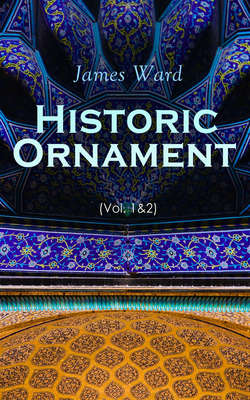Historic Ornament (Vol. 1&2)

Реклама. ООО «ЛитРес», ИНН: 7719571260.
Оглавление
James M Ward. Historic Ornament (Vol. 1&2)
Historic Ornament (Vol. 1&2)
Table of Contents
Volume 1
Table of Contents
PREFACE
INTRODUCTORY CHAPTER
CHAPTER II. PREHISTORIC ORNAMENT—PALÆOLITHIC PERIOD OR. EARLY STONE AGE—RIVER DRIFT AND CAVE-MEN
CHAPTER III. NEOLITHIC STONE PERIOD
CHAPTER IV. THE BRONZE AGE
CHAPTER V. THE IRON AGE
CHAPTER VI. THE LAKE DWELLINGS OF SWITZERLAND AND OTHER PARTS OF EUROPE
CHAPTER VII. EGYPTIAN ART
Egyptian Ornament and Industrial Art
CHAPTER VIII. CHALDEAN AND ASSYRIAN ART
CHAPTER IX. PHŒNICIAN ART
CHAPTER X. ART IN ANCIENT PERSIA
CHAPTER XI. GRECIAN PEOPLE AND MYTHOLOGY
CHAPTER XII. ART IN PRIMITIVE GREECE
CHAPTER XIII. THE GREEK AND ROMAN ORDERS OF ARCHITECTURE
CHAPTER XIV. GREEK AND ROMAN ORNAMENT
CHAPTER XV. INDIAN ART AND ARCHITECTURE
CHAPTER XVI. CHINESE AND JAPANESE ARCHITECTURE
CHAPTER XVII. EARLY CHRISTIAN AND BYZANTINE ARCHITECTURE
Byzantine Architecture
CHAPTER XVIII. SARACENIC ARCHITECTURE AND ORNAMENT
CHAPTER XIX. ROMANESQUE ARCHITECTURE AND ORNAMENT
CHAPTER XX. GOTHIC ARCHITECTURE AND ORNAMENT
CHAPTER XXI. RENAISSANCE ARCHITECTURE AND ORNAMENT
Ornament of the Renaissance
Volume 2
Table of Contents
CHAPTER I. POTTERY
Maiolica
Della Robbia Ware
Italian Maiolica
Persian, Damascus, and Rhodian Wares
French Pottery
Oiron Ware
Palissy Ware
Nevers, Rouen, and Moustiers Wares
French Porcelain
German Pottery
German Porcelain
English Pottery
English Porcelain
Chinese Porcelain
Indian Pottery
CHAPTER II. ENAMELS
Enamels of the Countries of the East
CHAPTER III. IVORY CARVINGS
CHAPTER IV. Metal Work
GOLD, SILVER, BRONZE, PEWTER, AND IRON
Spanish Metal Work
Niello-work and Damascening
Iron Work in France, Germany, Belgium, Italy and England
CHAPTER V. Furniture
ANTIQUE: EGYPT, ASSYRIA, GREECE, AND ROME
Byzantine, Romanesque, Saracenic, and the Furniture of the Middle Ages
Italian and other Furniture of the Renaissance
CHAPTER VI. TEXTILE FABRICS
Textiles of India
Embroidery
Lace
CHAPTER VII. MOSAICS
CHAPTER VIII. GLASS
CHAPTER IX. THE DECORATION OF BOOKS
Отрывок из книги
James Ward
Treatise on Decorative Art and Architectural Ornament (Complete Edition)
.....
In regard to the scarcity of voids and narrow sloping doorways, the similarity in Egyptian buildings of every kind is very striking (Fig. 105). This absence of voids gives a dark and gloomy character to the buildings, when compared with the architecture of other countries. The horizontal element and solidity of construction impart a look of powerful strength and of deep repose to the Egyptian temple. Even the tall and slender obelisks placed in front of the mighty pylons have little, if any, effect in removing the horizontal appearance of the whole building. We give the ground plan, perspective view, and front elevation of the great Temple of Luxor, as a typical illustration of an Egyptian temple from restorations by Chipiez (Figs. 106, 107, and 108). Its construction is described by Champollion as the “Architecture of giants.”
This double-temple was the work of two kings. From the second pylon to the further end of the Temple is the portion built first, by the King Amenophis III. The other portion, from first to the second pylon, is the part built by Rameses II. The sanctuary is placed in the centre of a hall, surrounded by small chambers. It has two doors, one at either end, and on the axis of the building it has a vestibule in front and a hall beyond, supported by twelve columns. Another hall in front of the Naos (or interior apartment) is supported by thirty-two lofty columns. In front of this again is a large square open court. This court is connected to the larger front peristylar court by a grand and lofty gallery, similar to a hypostyle hall. It is 176 ft. long, enclosed and covered, and richly decorated like the hypostyle hall at Karnak (Fig. 96). Four colossal seated statues are in front of the first pylon, and two obelisks, one on each side of the door-way. Four large flagstaffs and a double row of sphinxes in front of the temple complete the accessories to this great edifice. The whole building and obelisks were covered over with bas-reliefs and inscriptions.
.....